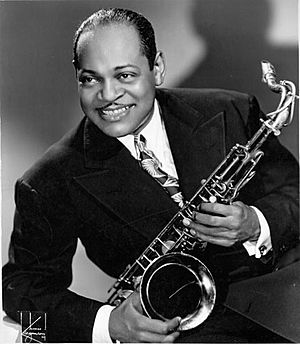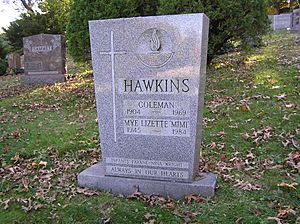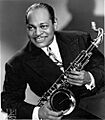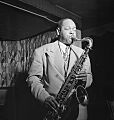Coleman Hawkins facts for kids
Quick facts for kids
Coleman Hawkins
|
|
|---|---|

Coleman Hawkins, c. 1945
|
|
| Background information | |
| Birth name | Coleman Randolph Hawkins |
| Also known as | "Bean", "Hawk" |
| Born | November 21, 1904 Saint Joseph, Missouri, United States |
| Died | May 19, 1969 (aged 64) New York City, United States |
| Genres | Jazz, Swing music, bebop |
| Instruments | Tenor saxophone, bass saxophone, clarinet |
| Years active | 1921–1969 |
| Associated acts | Ben Webster, Max Roach |
Coleman Randolph Hawkins (born November 21, 1904 – died May 19, 1969) was an American jazz musician. He was a famous tenor saxophonist. People often called him "Hawk" or "Bean."
Coleman Hawkins was one of the very first jazz musicians to make the tenor saxophone popular. Before him, this instrument was not often used in jazz. He helped show how amazing the saxophone could sound.
His playing style was very special. He used a rich, emotional sound with a lot of vibrato (a wavering effect). He also used a technique called arpeggios, which means playing the notes of a chord one after another. Many other saxophone players learned from his style.
Hawkins became well-known during the big band era with swing music. But he also played a big part in creating bebop, a new style of jazz in the 1940s.
Another famous saxophonist, Lester Young, once said that Coleman Hawkins was the "president" of the tenor saxophone. Even Miles Davis, a legendary trumpet player, said that listening to Hawk taught him how to play slow, emotional songs called ballads.
Contents
Early Life and Musical Beginnings
Coleman Hawkins was born in Saint Joseph, Missouri, in 1904. His mother's maiden name was Cordelia, and he was named Coleman after her.
He went to high school in Chicago and then in Topeka, Kansas. He later said he studied music at Washburn College while still in high school.
Coleman started playing piano and cello when he was young. He began playing the saxophone at age nine. By the time he was fourteen, he was already performing around eastern Kansas.
No one is completely sure why he was nicknamed "Bean." Some people think it was because of the shape of his head. Others say it was because he was careful with money, or because he knew a lot about music chords.
Coleman Hawkins' Amazing Career
Starting Out in the 1920s and 1930s
Coleman Hawkins got his first important job with Mamie Smith's Jazz Hounds in 1921. He played with them full-time from 1922 to 1923. Then, he moved to New York City.
He joined Fletcher Henderson's Orchestra and stayed with them until 1934. Sometimes, he also played the clarinet and bass saxophone. His playing changed a lot when Louis Armstrong joined the Henderson Orchestra in 1924–1925.
Hawkins became a featured soloist with the band. This meant he got to play special parts on their records. He also made his own recordings with other musicians.
In 1934, Hawkins went to Europe to play with Jack Hylton's orchestra in London. He toured Europe as a solo artist until 1939. During this time, he played and recorded with other jazz greats like Django Reinhardt in Paris.
While he was in Europe, other tenor saxophonists became popular in the U.S. But when Hawkins returned, he quickly became a top player again. He added new ideas to his already famous style.
On October 11, 1939, he made a very famous recording of the song "Body and Soul." In this recording, Hawkins barely played the original melody. Instead, he created new, exciting musical ideas. This recording was so new and different that it's seen as an early step towards the bebop style of jazz.
The 1940s and 1950s: New Sounds
After leading a big band for a short time in 1940, Hawkins led smaller groups. He played at Kelly's Stables in Manhattan.
Coleman Hawkins was always interested in new music and new talent. On February 16, 1944, he led what many people consider the very first bebop recording session. He played with other famous musicians like Dizzy Gillespie and Max Roach.
In 1945, he recorded many songs with small groups. He played with different kinds of musicians, showing he didn't care about labels like "modern" or "traditional" jazz. He also toured with a group called Jazz at the Philharmonic.
In the 1950s, Hawkins performed with musicians like Roy Eldridge. He also recorded Coleman Hawkins Encounters Ben Webster with another great tenor saxophonist, Ben Webster. His album The Hawk Flies High (1957) showed his interest in modern jazz.
Hawkins also reunited with Thelonious Monk, a famous jazz pianist. They had stayed friends for many years. In 1957, Monk led a recording session that included Hawkins and John Coltrane. This session created the album Monk's Music.
The 1960s: Later Years
In the 1960s, Coleman Hawkins often played at the Village Vanguard in Manhattan. In 1960, he helped record Max Roach's We Insist! album. This album was part of the connection between jazz and the civil rights movement.
In 1962, Hawkins got to record with the legendary Duke Ellington for the album Duke Ellington Meets Coleman Hawkins. He also recorded Today and Now in 1962, which is considered one of his best later works. In 1963, he recorded with Sonny Rollins for their album Sonny Meets Hawk!.
Sadly, Coleman Hawkins faced challenges in his later years. His last recording was in 1967. He passed away on May 19, 1969, in Manhattan. He was buried in the Woodlawn Cemetery in The Bronx, New York City.
A book about his life, The Song of the Hawk, was written in 1990 by John Chilton. It tells the story of Coleman Hawkins' amazing career.
Discography
Here are some of the albums Coleman Hawkins led or co-led:
- Rainbow Mist (1944)
- Body and Soul (1939–1956)
- The Hawk Talks (1952-53)
- The Hawk Returns (1954)
- The Hawk in Hi Fi (1956)
- The Hawk Flies High (1957)
- Coleman Hawkins Encounters Ben Webster (1957) with Ben Webster
- The Genius of Coleman Hawkins (1957)
- Bean Bags (1958) with Milt Jackson
- Soul (1958)
- Hawk Eyes (1959)
- Night Hawk (1960) with Eddie "Lockjaw" Davis
- Jazz Reunion (1961) with Pee Wee Russell
- Duke Ellington Meets Coleman Hawkins (1962) with Duke Ellington
- Today and Now (1962)
- Sonny Meets Hawk! (1963) with Sonny Rollins
He also played as a sideman on many other albums, including:
- Further Definitions (1961) with Benny Carter
- Monk's Music (1957) with Thelonious Monk
- We Insist! (1960) with Max Roach
Images for kids
See also
 In Spanish: Coleman Hawkins para niños
In Spanish: Coleman Hawkins para niños






